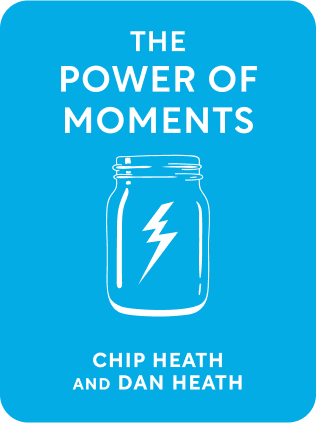

This article is an excerpt from the Shortform book guide to "The Power of Moments" by Chip Heath and Dan Heath. Shortform has the world's best summaries and analyses of books you should be reading.
Like this article? Sign up for a free trial here .
Is Chip and Dan Heath’s The Power of Moments worth reading? What is the key message to take away from the book?
In their book The Power of Moments, Chip and Dan Heath break down the elements of defining moments and teach you how to use them to make everyday experiences meaningful and memorable. They propose a four-element framework of a defining moment: 1) elevation, 2) insight, 3) pride, and 4) connection, and offer some strategies for using each element for making everyday moments special and meaningful.
Below is a brief overview of the key takeaways.
The Power of Moments: Why Certain Experiences Have Extraordinary Impact
Important and memorable moments—the grand events of your life that make you who you are, like your wedding or the first time you met your grandchild—are naturally meaningful to you. But smaller, everyday experiences—like a day at the beach or a fulfilling conversation with a friend—hold just as much power.
In their book The Power of Moments, authors Chip and Dan Heath show us how to turn daily, mundane experiences into defining moments. A well-engineered defining moment can have a tangible outcome like increased revenue from satisfied clients or improved test scores from motivated students. Other times, you’ll create defining moments with a more personal objective—deeper relationships with your friends and family, a better understanding of yourself and your values and motivations, or mentees who are confident in taking on new challenges.
(Shortform note: Several reviewers of The Power of Moments questioned whether defining moments can ever feel “real” if they’re engineered. This criticism misses a central idea of the Heaths’ argument—defining moments already exist and therefore are genuine. “Engineering” moments doesn’t mean staging a false event—it simply means giving attention and effort to important events that might otherwise go undetected.)
What Makes for a Defining Moment
Before they get into different methods of creating such moments, the Heaths discuss two foundational aspects of defining moments: They’re both meaningful and memorable.
The 4 Elements That Create Meaning
To engineer meaning, the Heaths say your moment should incorporate at least one of four emotion-boosting elements:
- Elevation: The moment is elevated beyond everyday experience, either through sensory pleasures or the element of surprise.
- Insight: The moment helps you discover something new about the world or yourself. Often, these moments have a transformative and influential effect on the course of your life.
- Pride: The moment gives you a sense of validation around your achievements or a sense of pride in your actions.
- Connection: The moment makes you feel more deeply connected to whoever shares it with you, and strengthens your relationship with them.
Shortform Commentary: Where These Four Elements Come From
The Heaths don’t note the exact research that led them to these four elements, but their ideas align closely with those of psychologist Abraham Maslow. Maslow is well-known for his “hierarchy of needs”, which describes the requirements for a person to become self-actualizing—constantly growing, discovering, and finding meaning in her life. There are five tiers to the hierarchy:
- Level 1: physiological needs such as food, water, and shelter.
- Level 2: safety needs such as physical health or law and order.
- Level 3: needs of belonging such as relationships and connectedness.
- Level 4: needs of esteem such as self-worth, respect, and achievement.
- Level 5: needs of self-actualization such as personal growth, peak experiences, and reaching your potential.
The Heaths’ four elements align with Maslow’s three “higher needs” of self-actualization, esteem, and belonging:
- Elevation: Self-actualizing people are capable of experiencing “transcendent” moments, or moments elevated above the everyday experience that create a sense of delight, wonder, and surprise.
- Insight: Insight is the core of the self-actualization tier of the hierarchy. As we’ll discuss, insight leads to personal growth, discovery, and a realization of your potential.
- Pride: Pride is the core of the esteem tier of the hierarchy. As we’ll discuss, pride helps you feel achievement and respect and increases your sense of self-worth.
- Connection: Connection is the core of the belonging tier of the hierarchy. As we’ll discuss, connection can strengthen your bonds with groups or in personal relationships.
In short, elevation, insight, pride, and connection are the elements that allow humans to live, not simply survive.
| What Makes a Moment Memorable? While the Heaths discuss what makes a moment meaningful, they don’t delve into what makes it memorable, which is the second characteristic of a defining moment. In order to be memorable, most defining moments should have an aspect of novelty or unexpectedness. Unexpectedness is important because when you experience emotions in a moment of surprise, you experience them more intensely than you would in an “everyday” situation. For instance, the joy of spending time with your friends isn’t as intense as the joy of being surprised with a puppy for your birthday. These high-intensity emotions send a signal to your brain that something important is happening—your brain responds by paying more attention than usual to the event at hand, while blocking out unrelated, external stimuli. |
Moments Defined by Elevation
Moments defined by elevation transcend everyday patterns and impart positive feelings like delight, motivation, and engagement. In short, elevated moments are the positive peaks that you look back on fondly.
(Shortform note: In his hierarchy, Maslow lists “peak experiences” as a component of the highest need, self-actualization. Maslow described peak experiences as small, everyday events that give us a feeling of newness or delight—in other words, as with elevated moments, we transcend everyday dullness.)
There are three ways to use elevation: Increase sensory pleasure, raise the stakes, and go off script with strategic surprise. Successful, memorable moments incorporate at least two of these methods.
Strategy 1: Increase Sensory Pleasure
Increasing sensory pleasure depends on making a moment look, feel, taste, or sound better than what you’re used to. For instance, getting dressed up to go out to a fancy restaurant looks, feels, and tastes different from eating in your sweatpants on the couch.
(Shortform note: The Heaths don’t discuss which sensory appeals work best, but numerous studies have concluded that memory links most strongly to your sense of smell. You can use this information to engineer small, special moments in a variety of contexts. For example, you might wear a certain “date night” perfume or cologne to make outings with your partner feel more special, or bake a certain type of cookie every Friday afternoon with your kids—each time you smell these particular scents, you’ll recall happy memories of your experiences.)
Strategy 2: Heighten the Stakes
The second way to elevate a moment is to raise the stakes. The Heaths explain that adding high stakes to a situation makes an otherwise flat, unengaging experience into a standout, exciting experience—for instance when you look back at your high school career, you’ll more likely remember your debate team championship than your algebra classes.
(Shortform note: One reason that high-stakes experiences stand out in your memory may be that the prospect of a high reward forces your brain to use long-term memory to “help out” your short-term working memory. As a result, your attention is more fully focused on the event—your brain re-engages in order to process all the information you’re taking in.)
Strategy 3: Go Off Script
The last method of elevating a moment is going off script, which the Heaths define as acting in a way that goes against what people expect. Meaningfully going off script doesn’t mean completely upending the scripts of your life. Memorable experiences are not wholly amazing—they’re largely mundane, with one or two exceptional peaks. Your goal, then, is to deliberately punctuate overall familiar and comfortable scripts with one or two strategic surprises.
(Shortform note: These strategic surprises are surprises that break behavioral patterns (or scripts) in a way that challenges assumptions about what comes next and draws the audience in.)
Example: The Difference Between Easy Surprises and Strategic Surprises
You want to make your weekly HR meeting more engaging. There are two ways you might go about it:
- Scenario A: You bring cupcakes to your meeting. It’s a nice gesture, but the surprise isn’t memorable or meaningful because the rest of the meeting unfolds the same way it always does.
- Scenario B: You examine your meeting’s script and decide to add a strategic surprise. You assign each of your team members a “new hire” role and send them out to interview their “new teams” for advice on maintaining work/life balance. At the end of the hour, your team members meet up and discuss their new insights. By going off your regular meeting script, you’ve elevated the experience and created a defining moment for your team members.
Moments Defined by Insight
The second element you can use to create defining moments is insight. Moments defined by insight inspire realizations or transformations that affect your future choices and actions. The Heaths suggest three ways you can spark meaningful, memorable insight: forcing others to confront an uncomfortable truth, putting yourself in situations where you must confront self-truths, and mentoring others.
1) Force Someone to Confront a Truth
The Heaths first explore how you can spark insight in others by setting up a moment in which they will be forced to confront an uncomfortable truth. They note three essential factors to making the moment defining:
- Have a clear conclusion: Know exactly what conclusion you want your audience to come to. This is often the easiest part of the process—you usually know exactly what truth needs revealing.
- Operate on a short time frame: Create a situation that will guide your audience to their discovery over a matter of minutes or hours, or even more immediately.
- Allow audience discovery: Let the audience discover the conclusion themselves, instead of telling them what to do.
These factors result in an “aha! moment,” or what psychologist Roy Baumeister dubbed the crystallization of discontent: a sudden moment in which any vague negativity or discomfort you’re feeling suddenly crystallizes in a pattern—you discover links between seemingly unrelated issues and the core problem becomes startlingly clear.
2) Set Up a Situation for Self-Insight
The Heaths explain that using insight to create defining moments for yourself depends on pushing your boundaries—you must put yourself in situations that expose you to the possibility of failure. This is because the process of stepping outside of your comfort zone and risking failure leads to what psychologists call “self-insight”: an understanding of your values, abilities, goals, and motivations.
When you put yourself in risky situations, either you will succeed or you will fail. While success is certainly a reason to celebrate, keep in mind that failures—and the valuable learning opportunities they offer—should be celebrated as well.
3) Push Others Into Self-Insight as a Mentor
As a mentor, your job is to push your mentee into situations that will spark her self-insight, providing the type of productive pressure that helps coax out her best self. The Heaths note that great mentors do four key things: Set high expectations, express confidence in the mentee, provide direction, and assure support. This formula sends the message, “I have high expectations, but I know you can reach them. I will present new challenges to you, and I will have your back if you fail.”
Moments Defined by Pride
The third element you can use to create a defining moment is pride. Moments defined by pride surface and celebrate your best self—the “you” who earns recognition for your efforts, crushes ambitious goals, and acts with courage in situations that call for it. The Heaths suggest three strategies for multiplying instances of achievement and recognition:
- Build small, personally motivating “wins” into the journey toward a big goal.
- Recognize others’ efforts and make their progress visible.
- Prepare yourself to act with courage when necessary.
Strategy 1: Create and Celebrate Small Wins
The Heaths explain that everyone approaches goals differently: Some people might feel that accomplishing the goal is the only thing to be proud of, and others might think the journey to the goal is just as important as the goal itself. The Heaths suggest enhancing the instances of pride you feel while working toward a goal by adding small, personally motivating wins into the journey.
(Shortform note: Recall the fixed mindset and growth mindset discussion from Carol S. Dweck’s Mindset: Those with a fixed mindset often only care about the achievement of the goal, and those with a growth mindset can more easily see the value of the journey. The Heaths’ suggested strategy of celebrating small wins is helpful because it caters to both these mindsets. The frequent achievements cater to those with a fixed mindset, and the value placed on the pursuit of a goal caters to those with a growth mindset.)
Goals are often too large and ambiguous, and it’s all too easy to get lost along the way between Here and There or become discouraged or demotivated. Building small, achievable, and fun wins into the journey toward your goal serves several important purposes:
- Small wins are concrete and create a clear roadmap in the right direction.
- You’re more likely to stay engaged with small wins based on your particular motivations.
- You allow yourself multiple opportunities to feel good about your abilities.
(Shortform note: Studies have also shown that continuously celebrating small achievements is a fairly easy way to boost your overall happiness—it’s much easier to continue pursuing a goal when it feels good, or even fun, rather than like a chore.)
For example, if you want to lose weight, it’s best to abandon the old, vague roadmap of “eat healthy and exercise.” Think of small goals that feel like causes for celebration to you such as using the stairs instead of the elevator, cutting out soda for 30 days, going for a drink with friends when you hit 10,000 steps for the day, and logging 50 Zumba classes.
Strategy 2: Recognize Efforts and Progress
The Heaths note that there’s a common misconception that people who work hard are likely to feel proud of their work. It’s not so simple: Pride doesn’t come from hard work alone—it comes from the results of your hard work being noticed.
(Shortform note: Research shows that the strongest indicator of productivity is how a team member feels—if she feels positively toward her organization and herself and is motivated by her work, her productive performance will naturally increase. Team leaders, therefore, should focus their efforts on their team members’ feelings. The research determined that the most effective way to lift a team member’s mood is to make sure that she has a consistent sense that she’s making progress in meaningful work—what the researchers dubbed the progress principle.)
Recognition is the easiest way to use the progress principle to create pride for others. Pride that comes from recognition is especially memorable—largely because it’s so rarely practiced. When practicing recognition, your focus should be on the frequency of your praise, not the grandeur. People feel most satisfied when their efforts are being recognized consistently, not just when they accomplish a big goal.
(Shortform note: The progress principle specifies that team members who have a consistent sense of their progress experience heightened mood and productivity. Frequent recognition meets this need as well as reminding the team member that their work has meaning.)
Strategy 3: Prepare Yourself Mentally for Courage
The Heaths say that the third way to create pride is to act with courage—standing up for someone else, calling out injustice, or fighting for something we believe in.
(Shortform note: In Dare to Lead, Brené Brown—an expert on shame and vulnerability—explains “practicing courage” as developing unwavering integrity: A commitment to acting in alignment with what you understand, personally, to be the right thing to do—even in situations that make you feel vulnerable or exposed to the risk of failure.)
The Heaths note that while you might not have any control over when opportunities to act with courage appear, you do have control over how you react to these opportunities.
Usually, when you see something wrong or unjust, you don’t react right away, or at all—most people don’t naturally know how to immediately react to these situations. Without a specific planned response, we end up spending too much time deliberating what we should or could say or do, and miss the moment.
(Shortform note: In their book Switch, the Heaths put a name to this phenomenon of clamming up when faced with the task of making a choice—decision paralysis. When presented with numerous options or ambiguity, we’re predisposed to conserving our mental energy by defaulting to whatever decision feels easiest or most familiar, or not doing anything at all.)
To avoid decision paralysis, plan out exactly how you’d respond to an opportunity to act with courage—what the Heaths call “preloaded responses.” Preloaded responses are reactions that you’ve drilled into your memory so that they’re immediately ready in a situation that calls for it.
- For example, “When I see Bill and his friends mocking my sister at school, I will walk over, ask them to stop, and walk her to class. ”
While thinking of your preloaded responses, ask, “How can I get the right thing done?” This question asserts that you know what’s right and now must make it happen. It’s not a matter of what you should do, but what you will do.
Shortform Commentary: Support Preloaded Responses With Precommitments
Asserting that you know the right thing to do and planning out how to make it happen can apply to smaller, very personal moments of courage as well. Doing the right thing and acting with integrity matters, even if you’re doing it just for yourself. To help you with this, you might support your preloaded response with a precommitment—a pact you make with yourself about the way you’ll act in a certain situation.
In his book Indistractable, Nir Eyal outlines several ways you can use precommitments to push yourself into doing the right thing:
- Create social pressure: This kind of pact makes it harder to do something undesirable. You might make a precommitment with someone else—you’re not likely to break the pact because of the added pressure of being “watched” by someone else. For example, you might ask a friend to walk home from work with you every day so you don’t stop at the bar.
- Put money on the line: This kind of pact attaches money to your precommitment—if you break it, you lose the money. You might attach a $100 bill to your fridge and make a pact: If you buy beer, you have to burn the money.
- Identify with your future self: Commit to the identity you want to have by talking about yourself as someone who has that identity. For example, instead of saying, “I’m someone who’s trying to quit drinking,” you might say, “I’m someone who is quitting drinking.”
Moments Defined by Connection
The fourth element you can use to create a defining moment is connection. Moments defined by connection are experiences that can strengthen your group relationships or deepen your individual relationships.
Part 1: Use Connection to Strengthen Group Relationships
Defining moments for groups happen in experiences that create a shared meaning for everyone present—experiences that underscore the mission everyone is working toward together. These experiences are essential for reminding the group members that they’re united in something important and larger than themselves. The Heaths identify three steps to create moments of connection for groups: 1) Create a shared moment, 2) Allow for voluntary struggle, and 3) Reconnect members with their work’s meaning.
1) Create a shared moment: The social reality of being together with a group of people working toward the same cause is essential to understanding the magnitude of the group’s impact.
(Shortform note: Researchers find that remote work contributes strongly to lower employee job satisfaction and motivation. Many employees attribute this to a lack of social contact (or shared moments): Without the opportunity to meaningfully collaborate and chat with colleagues or see the impact of their work on clients, the work experience becomes endless, disengaging flatness.)
2) Allow for voluntary struggle: People naturally create strong bonds when they are struggling together, but they need to have chosen to be part of it. People who are forced to take on extra work become resentful and disengaged, whereas those who choose to struggle will have a genuine connection to the work and to others who do the extra work for the same reasons.
(Shortform note: Shared struggle is a powerful bonding tool—the Heaths discuss how it might bring together people who are already part of the same group, but studies have shown that pain or struggle enhances bonding in groups of people without any shared identity. Part of the reason for this is that struggle naturally forces group members to ask for help and show vulnerability, which is a foundational element of relationship-building.)
3) Reconnect with work’s meaning: Group members need to know that their work is much larger than themselves—you have to cultivate a group’s sense of purpose by showing them the impact of their work. Purpose is what allows people to see beyond their mundane or difficult individual tasks and feel a significant connection to the larger mission.
(Shortform note: Many organizations try to cultivate their employees’ passion instead of their purpose, but passion is a poor motivator that has caused a recent decline in workplace satisfaction: Studies cited in Cal Newport’s So Good They Can’t Ignore You show that only 45% of Americans report being happy with their jobs, likely because they feel that they should be doing something that aligns with their passions.)
Part 2: Use Connection to Deepen Individual Relationships
The Heaths explain that, contrary to what you might think, relationships do not naturally deepen or grow stronger over time. Without regular maintenance, relationships easily plateau—they won’t develop any further without a bit of engineering. A properly maintained relationship has positive peaks that serve as the defining moments that deepen the relationship.
In relationships, these positive peaks happen in instances of responsiveness—engagement with someone else that makes it clear that you’re listening to and care about them. Responsiveness conveys three essential messages:
- Support: I actively support you and will help you get what you want or need.
- Understanding: I know what’s important to you and who you are.
- Respect: I respect who you are and your wants or needs.
Responsiveness in Personal Relationships
In personal relationships, responsiveness is part of a formula: vulnerability + responsiveness = intimacy. In practice, this formula looks fairly simple: You share something (vulnerability) and then wait to see if the other person shares something in return (responsiveness). By choosing to respond, they express respect, understanding, and support.
The Heaths stress that intimacy doesn’t come from either responsiveness or vulnerability alone—it’s crucial that there’s an exchange between the two. When completed, this simple exchange allows the relationship to progress and deepen instead of plateauing. Keep in mind that this exchange doesn’t happen naturally—someone needs to take the first step to start the cycle of vulnerability. If you want richer, deeper connections, you must either be willing to be open with others or recognize when others are opening up to you.
Conclusion: What Defining Moments Give Us
Looking for moments that you can enhance with elevation, pride, connection, or insight can multiply the rich experiences that make your life meaningful. Focusing on meaningful moments is a way to reconnect with what’s important to a well-lived life. Investment in these moments offers you the opportunity to re-engage with your life and fight against the everyday flatness that causes days, months, and years to speed by.

———End of Preview———
Like what you just read? Read the rest of the world's best book summary and analysis of Chip Heath and Dan Heath's "The Power of Moments" at Shortform .
Here's what you'll find in our full The Power of Moments summary :
- How to make everyday experiences meaningful and memorable
- A look at the four elements that create meaning
- How your senses can play a role in elevating everyday moments






